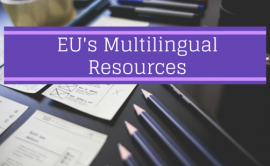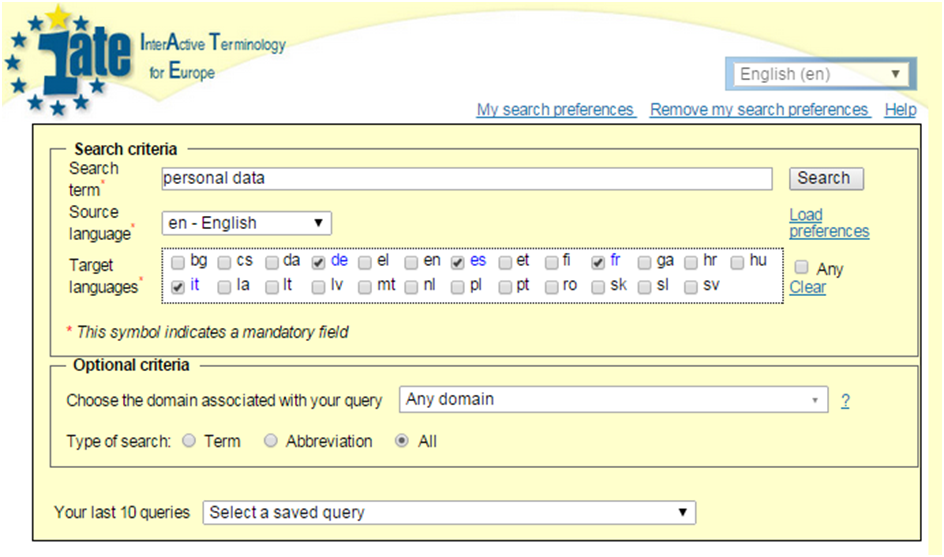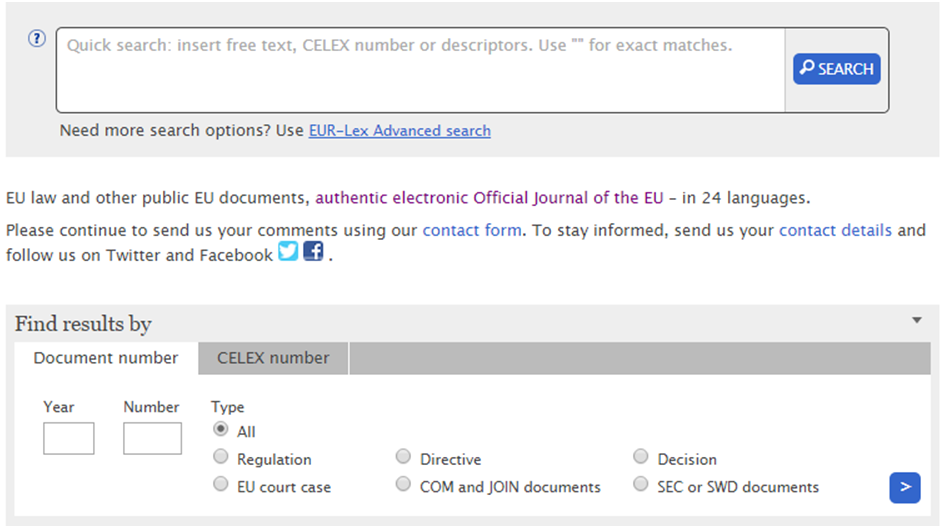
On July 1, 2013 the European Union welcomed its 28th member state, Croatia, together with its 24th official language.1 The motto of the European Union (EU) is “unity in diversity,” and since it was established, the EU has been committed to multilingualism. As the number of official languages grew from four in 1958 to 24 in 2013, the EU commitment (and challenge) to provide its citizens with access to legislation in multiple languages fostered the development of online resources.
Today, EU treaties, regulations, directives, public documents, and databases are available online free of charge in several languages, and they can be a mine of information and prove very useful to language professionals working on a wide range of subjects. Whether you work on medical, financial, or technical texts, you can take advantage of several interinstitutional websites and databases in almost any language combination of the 24 official languages—that’s 552 language pairs! The following provides an overview of what some of these fabulous resources have to offer.
Inter-Active Terminology for Europe

Figure 1: Inter-Active Terminology for Europe database
Inter-Active Terminology for Europe (IATE) is a free EU interinstitutional terminology database, where EU institutions and agencies collect and share EU-specific terminology. It currently contains about eight million entries in 24 languages, which are accessible through the IATE website and downloadable in TBX format.
The database is extremely intuitive and easy to use. (See Figure 1.) It consists of three mandatory fields (search term, source language, and target languages) and two optional criteria (domain and type of search). You insert the term for which you are looking in the “Search Term” field, select the source and target languages, and hit “Search.” You can select 23 languages as target languages, plus “Latin” and “Any” (to select all languages).

Figure 2: IATE search results
On the results page, you will see a list of all the results found in the database for that entry in the target languages you have selected. (See Figure 2) On the right of the screen, you will find some additional information that can help you evaluate the suggested translation. Each result is ranked with a star system that goes from one to four stars, based on whether that term/group of terms has been verified. The @ sign provides information about the term reference, so any associated EU directive or regulation or other material will be displayed. The other icons indicate context, notes, and the full definition. All of this information can be retrieved by simply hovering over or clicking on the icons, or by clicking on “Full Entry” on the top right. Not every term is so detailed, but it generally gives you a solid start in your search for the correct term.
What are IATE’s pros and cons?
Pros: Intuitive and easy to use, Reliability (new, full entries), Massive database, Numerous language combinations
Cons: Duplicate entries, Old entries, Unverified entries

Figure 3: Navigating EUR-Lex
EUR-Lex provides free online access to all EU documentation, so it’s particularly useful to retrieve information included in the Official Journal of the European Union, EU law (treaties, directives, regulations, decisions, consolidated legislation, etc.), preparatory acts (legislative proposals, reports, green and white papers, etc.), EU case law (judgements, orders, etc.), international agreements, European Free Trade Association documents, and other public documents. All of this material is provided in 24 official languages, and the portal itself is in all 24 official languages.
Why Is EUR-Lex Useful?
Certain financial and medical texts, or other documents pertaining to highly regulated fields, might mention EU directives or regulations and use the same terminology used within those texts. Being able to access these documents is vital to ensure that your translation is consistent with approved terminology. In addition, it might save you a lot of research time and improve the final quality of your translation. In fact, those official documents are the ones that professionals in the field have to keep in mind and refer to when they draft their own reports, contracts, statements, etc., and by using the same language, you prove yourself to be an expert in the field.
How Do You Navigate EUR-Lex?

Figure 4: EUR-Lex results page
The best way to navigate the website is through its search functions. On the home page (http://eur-lex.europa. eu), you will immediately find the “Search” box and the “Find results by” box. (See Figure 3)
The “Search” box is self-explanatory and will result in a list of documents that contain the term/group of terms. If you type more than one word and are looking for exact matches, use “” as suggested. In the “Find results by” box you can search by document type and number. For example, if your source text refers to Directive 95/46/EC, you can retrieve it here easily.
Both search types (simple and by document) take you to the results page displaying all relevant documents. After you find what you’re looking for, you can view it in all languages and formats available and even with a multilingual parallel view, which displays up to three languages at the same time. (See Figure 4)
What Happens If You Don’t Use Official Terminology?
If your source text mentions or refers to an official EU document, not following or retrieving official terminology might cost you more than you think:
- You’ll waste time researching and deciding on terms or groups of terms that have already been translated and approved in the industry.
- Your target audience might find your translation vague or ambiguous (if not incorrect), since it is highly likely that they’ll be familiar with official terms in their fields.
- You will not present yourself as an expert.
CURIA gathers all judgments, orders, and opinions from the European Court of Justice. A search box appears on the home page where you can type in the case number and other relevant information. So, for example, if you’re working on a translation and a judgment is mentioned, this is the first place you want to go. Once you type in all of the information, you can view the document in several languages and also consult the list of connected documents. You can hover over the html or pdf icons and view a list of languages available. By clicking on the EUR-Lex icon on the right you will be linked back to EURLex, which allows you to have a parallel view of two or three languages.
EuroVoc is a multilingual, multidisciplinary thesaurus that covers terminology from different EU fields. Terms are available in 24 languages. Although you can use it to search for terms and their translation, EuroVoc is great for building glossaries and term bases, or for study purposes.
The database is organized by domains and subdomains, and the relationship among terms can be an associative relationship, equivalence relationship, hierarchical relationship, etc. You can use the “Simple search” field to browse the site by subject and download the whole database by domain or language pairs.
The Publications Office of the European Union has developed a style guide as a result of the requirement to publish official documents in 24 languages. The guide harmonizes writing practices while keeping the specific elements of each language. By doing so, documents in all languages are comparable, and different institutions can work and publish texts while taking into consideration common guidelines.
Who Uses the Style Guide?
Authors, editors, lawyer-linguists, terminologists, translators, proofreaders, and anyone else who works on EU texts.
What Does the Style Guide Include?
The style guide consists of four parts addressing the following:
1) the official EU journal,
2) general publications,
3) conventions common to all languages, and
4) publications in a specified target language.
Parts 1-3 are identical in all languages, and Part 4 is specific to each official language. Although not all parts might be relevant to us as freelance translators, it’s still a good resource. Part 4 is particularly useful. It contains rules on punctuation, spelling, conventions of lower and upper case, etc. Unlike a grammar book, it doesn’t teach you how to use punctuation or tenses, but it covers gray areas for each target language. For example, the section about the use of upper and lower case in Italian is particularly interesting. A common mistake among inexperienced translators from English into Italian is to follow the English capitalization, producing an incorrect translation that is unpleasant to read. This section also provides explanations on correct capitalizations and relevant examples.
There is a list of annexes at the end of the style guide. Particularly useful is Annex A5 “List of Countries, Territories, and Currencies,” which provides a comprehensive list of countries with the following information (we will use Poland as an example):
- Short name: Poland
- Full name: Republic of Poland
- Country code: PL
- Capital/Administrative Center: Warsaw
- Citizen/Inhabitant: Pole
- Adjective: Polish
- Currency: zloty, pl. zlotys
- Currency Code: PLN
- Currency Subunit: grosz, pl. groszy
Resources to Save Time and Improve Accuracy
In conclusion, IATE is great for specialized terms and acronyms, EURLex is the place to go to retrieve EU regulations, directives, etc., while CURIA collects EU case law. To build glossaries and improve vocabulary and style, EuroVoc and the EU Style Guide are extremely useful. Once you learn to use each resource appropriately, you will turn to them automatically and save yourself time and effort while producing a more accurate translation and an excellent finished product.
This article was originally published in The ATA Chronicle (June 2015), the monthly magazine of the American Translators Association (www.atanet.org).
Header image credit: Picjumbo
Header image edited with Canva
Author bio
Silvia D’Amico is a freelance translator working from English, Greek, and Spanish into Italian. After receiving her MA in conference interpreting and translation studies from the University of Leeds (U.K.), she was selected to take part in a training program at the Italian Translation Unit of the European Parliament in Luxembourg. Since then, she has been working as a full-time translator specializing in European Union affairs and legal and business material. She is currently serving as the secretary of the Northeast Ohio Translators Association, an ATA chapter. Contact: silvia@damicotranslations.com.








